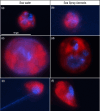Contribution of Large Marine Aerosols in Phytoplankton Dispersal
- PMID: 40179244
- PMCID: PMC12004932
- DOI: 10.1021/acs.est.4c14473
Contribution of Large Marine Aerosols in Phytoplankton Dispersal
Abstract
Sea-spray aerosol (SSA) plays a crucial role in climate processes by influencing radiative forcing, cloud formation, and precipitation. While SSA particles with diameters between 0.1 and 10 μm are commonly studied, larger aerosols (>20 μm) have been observed over terrestrial and oceanic regions but are generally overlooked. Large bioaerosols can be formed by pollen, fungal spores, and cell debris. However, the abundance, dynamics, and composition of large marine aerosols remain poorly understood. This study observed wave and atmospheric conditions driving aerosol production, the resulting SSA abundance, and sizes (up to 90 μm), and collected collocated SSA samples for microscopy analysis during a two-month time period. SSA above 20 μm were frequently observed, containing a diverse range of intact phytoplankton cells, including small flagellates (2 μm), to diatoms, and colonial cells (above 40 μm). The abundance of small flagellates suggests that sea-to-air transfer may be an important, yet overlooked, dispersal mechanism for these groups. To the best of our knowledge, this is the first evidence of direct airborne observation (rather than deposition) of large intact phytoplankton cells. These findings highlight the ubiquity of large marine aerosols and their capacity to carry intact phytoplankton cells.
Keywords: aerosols; bioaerosols; large aerosols; phytoplankton; sea-spray; transport.
Conflict of interest statement
The authors declare no competing financial interest.
Figures







Similar articles
-
Size-dependent changes in sea spray aerosol composition and properties with different seawater conditions.Environ Sci Technol. 2013 Jun 4;47(11):5603-12. doi: 10.1021/es400416g. Epub 2013 May 23. Environ Sci Technol. 2013. PMID: 23638996
-
Isotopic Insights into Organic Composition Differences between Supermicron and Submicron Sea Spray Aerosol.Environ Sci Technol. 2022 Jul 19;56(14):9947-9958. doi: 10.1021/acs.est.2c02154. Epub 2022 Jun 28. Environ Sci Technol. 2022. PMID: 35763461
-
The Sea Spray Chemistry and Particle Evolution study (SeaSCAPE): overview and experimental methods.Environ Sci Process Impacts. 2022 Feb 23;24(2):290-315. doi: 10.1039/d1em00260k. Environ Sci Process Impacts. 2022. PMID: 35048927 Review.
-
Bringing the ocean into the laboratory to probe the chemical complexity of sea spray aerosol.Proc Natl Acad Sci U S A. 2013 May 7;110(19):7550-5. doi: 10.1073/pnas.1300262110. Epub 2013 Apr 25. Proc Natl Acad Sci U S A. 2013. PMID: 23620519 Free PMC article.
-
Marine Aerosols and Clouds.Ann Rev Mar Sci. 2018 Jan 3;10:289-313. doi: 10.1146/annurev-marine-121916-063148. Epub 2017 Oct 13. Ann Rev Mar Sci. 2018. PMID: 29029576 Review.
References
MeSH terms
Substances
LinkOut - more resources
Full Text Sources
Research Materials

